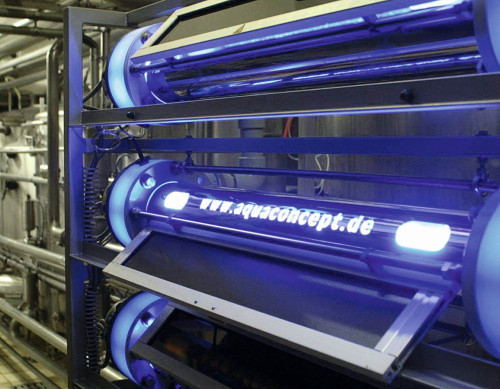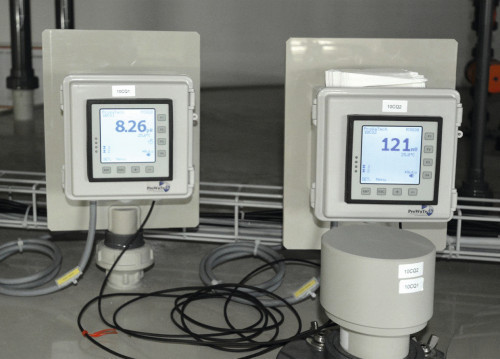Question: Due to our process, cyanide waste water containing copper and nickel collects in a batch container. We currently have this collected, but in the long term this is a major cost factor. What options are there for treating such a mixture directly in the batch tank?
Answer: The classic method for detoxifying cyanides is the use of NaOCl or Cl2 gas, whereby NaOCl is also formed during injection into the alkaline medium.
2NaOH + Cl2 → NaCl + NaOCl + H2O
Although the chlorine gas plant technology is more extensive, it no longer poses any problems today. However, detoxification with chlorine gas has the advantage of adding the oxidizing agent as a 100% "solution" (chemical). With sodium hypochlorite, on the other hand, up to 85% water is added, as this oxidizing agent is sold as an approx. 15% solution. With large quantities of wastewater, the space saved by using chlorine gas makes up a lot.
The problem: With a higher cyanide content, this will generally not work with nickel because the compound is far too stable, e.g. Ni(CN)2 or K2[Ni(CN)4] (potassium tetracyanonickelate(II)). You are welcome to try this yourself in a beaker and add an excess of NaOCl to the waste water. If the nickel and cyanide concentrations are sufficiently high, this should not be successful even after a year of reaction. If the concentrations are low and the excess is high enough, it may still work. In this case, the AOX should not be ignored [2].
Oxidation with hydrogen peroxide will not work, as the oxidizing power is lower. There is also the copper content. If the dosage is too high, the H2O2 reacts catalytically with the copper present. To put it bluntly, this can cause the waste water to jump out of the batch.
Peroxomonosulphuric acid (also known as caroate or Caro's acid) is a good option, at least in theory. However, it is relatively expensive, reaction times can be quite long and it reacts exothermically. The storage of pure peroxosulphuric acid should also be considered critical, as it is explosive.
Even if there are other possibilities that have found a niche in practice (such as ozone or anodic oxidation), we therefore recommend the combination of UV light and H2O2. The details have already been discussed in detail in [3], which is why only an overview is provided here.
UV oxidation
 Cyanide detoxification using a UV reactorOxidationwith UV light is normally associated with the addition of hydrogen peroxide. The copper plays a rather subordinate role here, as these facilities are designed in such a way that the H2O2 is added finely in the bypass. This means that there is never a local overdosage of the oxidizing agent.
Cyanide detoxification using a UV reactorOxidationwith UV light is normally associated with the addition of hydrogen peroxide. The copper plays a rather subordinate role here, as these facilities are designed in such a way that the H2O2 is added finely in the bypass. This means that there is never a local overdosage of the oxidizing agent.
Very compact reactors are used for UV oxidation, which usually consist of a stainless steel tube with an inserted quartz tube. The quartz tube contains the UV lamp with a standard output of between 1-12 kW. High-pressure and low-pressure mercury lamps are used. The dwell time of the waste water is in the range of 5-10 seconds, so that the UV reactor can be very small even with large quantities of water.
The resulting short-wave UV radiation is able to attack chemical bonds directly and thus lead to the degradation of organic molecules. This means that not only cyanide is oxidized, but COD and TOC are also broken down. The second reaction path is via the production of OH radicals from the splitting of H2O2molecules. As very strong oxidizing agents, the OH radicals are able to break down the organic compounds.
Due to the side reactions, i.e. COD and TOC degradation, UV oxidation generally takes longer than with NaOCl. In practice, values of 12-72 h are given, whereby in our experience the 72 h are mixtures that cannot be treated at all with sodium hypochlorite.
Ammonium
No matter which method is used for oxidation, some ammonium (acidic range) or ammonia (alkaline range) will always be produced [3].
Ammonia is a nutrient that can lead to eutrophication when discharged into water bodies. It also acts as a fish poison. In the case of indirect discharge via the sewage system, it is a food for microorganisms in sewage treatment plants. If it is discharged directly, the ammonia must be removed from the wastewater.
The formation of ammonium compounds after the oxidation of cyanite should not be neglected. This usually occurs to an extreme extent if phosphate treatment takes place after cyanide detoxification. By lowering the pH value, ammonium compounds are formed from the cyanate (CNO). Intermediate oxidation at pH 7-8 (further oxidation of the cyanate to C and N compounds) should first be tested in the laboratory before implementation.
If ammonia or the ammonium compounds are present in the range of a few g/L, ammonia stripping is justified. The use of a bubble reactor, in which finely dispersed air or water vapor expels ammonia under alkaline conditions, is possible but expensive. In this case, the ammonia gas contained in the air flow can be recovered in a second stage via a washing tower (solid state, droplet catcher). Washing can be carried out with acids. This produces ammonium sulphate or ammonium phosphate.
For low ammonia concentrations, the magnesium ammonium phosphate precipitation (MgNH4PO4) known from analytical chemistry can be used. The problem here is maintaining a limited pH value of 9 and a required stoichiometric excess of magnesium and phosphorus salts in order to achieve values below 20 mg/L. In addition, there is an extremely high sludge formation, which is the reason why this method is not used in practice.
Metal precipitation
As soon as the cyanides and ammonium have been removed from the wastewater, the classic metal precipitation process begins.
The following compounds are used as precipitants:
- Alkali hydroxides (NaOH)
- Milk of lime (Ca(OH)2)
- Alkali carbonates (Na2CO3) = sodium carbonate.
 Values such as pH value, temperature and redox must be continuously monitored during detoxificationAsuccessful precipitation refers to compliance with the limit values (when all metals have reacted). If problems occur, a different precipitant with a lower solubility product must be used (alkali sulphides, organosulphides, etc.).
Values such as pH value, temperature and redox must be continuously monitored during detoxificationAsuccessful precipitation refers to compliance with the limit values (when all metals have reacted). If problems occur, a different precipitant with a lower solubility product must be used (alkali sulphides, organosulphides, etc.).
The use of sulphides should be chosen with care, as sulphides themselves are considered toxic. In addition, precipitation with sulphides should only take place after hydroxide precipitation in order to avoid ongoing recomplexation.
Ideally, sulphide treatment should be carried out after the wastewater has already been filtered. If re-dissolution of the precipitated hydroxides is avoided (they have already been filtered), a lot of chemicals can be saved. In addition, this procedure proves to be process-safe, as subsequent reactions and shifts in equilibrium cannot be ruled out in the presence of metal hydroxides.
The limit value for copper is 0.5 mg/L. With the addition of NaOH or Ca(OH)2, precipitation begins at pH 5.8, with Na2CO3 already at pH 5.6. Depending on the composition of the wastewater, a drop below the limit value can be expected from pH 7.8.
The situation is slightly different for nickel. The limit value is also 0.5 mg/L, in exceptional cases 1.0 mg/L. Precipitation starts from pH 7.8, below the limit value only from pH 9.8. Due to the presence of other cations (such as copper), a slightly earlier drop below the limit value is to be expected (approx. pH 9.2-9.5, depending on the concentration).
The mixture is then flocculated. The interfacial charge is removed by adding electrolytes, the effect of which increases exponentially with increasing valency. If the electrolytes consist of solutions of slightly hydrating metal salts, e.g. FeCl3 or Al2(SO4)3, as is usual in the coagulation of wastewater constituents, then not only do they coagulate, but adsorption processes also occur. This combination is called adsorption coagulation. If these metal salt solutions are added in excess, the fine particles are also mechanically incorporated into the coarser iron(III) hydroxide or aluminum hydroxide flakes, which improves sedimentation.
Flocculation is a process that often follows coagulation, but can also be used on its own. This is particularly the case if the agents used are ionogenic and therefore also lead to coagulation. Organic macromolecules with an elongated structure, which are soluble in water and can attach electrostatically or chemically to colloids or very fine particles, are suitable for flocculation.
It is important that the macromolecules adhere to the particles at one end or lengthwise and that the other end reaches as far as possible into the electrolyte. This can then attach another particle in the same way.
This results in larger clusters held together by these thread-like molecules, which are easy to sediment or accelerate sedimentation. Substances that cause such flocculation are called flocculants.
The hydroxides that precipitate as sludge are usually filtered using a filter press / chamber filter press [2].
Literature
[1] CyanoMat - Modern cyanide detoxification by means of UV oxidation - Galvanotechnik 10/2001
[2] Environmental technology part 1 - Waste water treatment https://www.galvanotechnik-for-you.de/kurse/umwelttechnik-teil-1-abwasserbehandlung/
[3] Cyanide detoxification with UV oxidation - Galvanotechnik 05/2021


